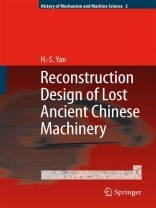Ancient China was outstanding in mechanical technology before the 15th century. Numerous ingenious machines were invented. However, due to incomplete documentation and loss of finished objects, most of the original machines cannot be verified and many of the inventions did not pass down to later generations. This book, based on the author’s research and teaching experiences over the last 20 years, is devoted to presenting an innovative methodology in the area of mechanical historiography for the systematic reconstruction design of ancient Chinese machines that have been lost to time. Its purpose is to generate all possible design concepts of lost machines. If the defined and/or concluded design specifications, topological characteristics, and – sign requirements and constraints are feasible, one of the resulting rec- struction designs should be the original design. Such an approach provides a logical tool for historians in ancient mechanical engineering and techn- ogy to further identify the possible original designs according to proven historical archives. However, this work will not deal with the credibility of historical literary works. It supposes that the lost machines existed, and tries to demonstrate the feasibility of reconstructing the lost designs. The book is organized in such a way that it can be used for teaching, research or self-study. Chapter 1 introduces the study, classifications, and process for the reconstruction design of ancient machinery.
Innehållsförteckning
Preface; 01 Introduction; 01.01 Study of Ancient Machines; 01.02 Classifications of Ancient Chinese Machines; 01.02.01 Classifications based on applications; 01.02.02 Classifications based on historical archives; 01.03 Reconstruction Design of Ancient Machines; 01.03.01 Study ofhistorical archives; 01.03.02 Reconstruction analysis; 01.03.03 Reconstruction synthesis; 01.04 Scope ofthe Text; References; 02 Mechanism and Machine; 02.01 Definitions; 02.02 Mechanical Members; 02.03 Joints; 02.04 Mechanisms and (Link-) Chains; 02.05 Constrained Motion; 02.05.01 Planar mechanisms; 02.05.02 Spatial mechanisms; 02.06 Topological Structures; 02.07 Mechanism and Machine Design; 02.08 Structural Synthesis of Mechanisms; References; 03 Ancient Chinese Machines; 03.01 Historical Development; 03.02 Labor Saving Devices; 03.02.01 Wedge; 03.02.02 Inclined plane; 03.02.03 Screw; 03.02.04 Lever; O3.02.05.Pul1ey; 03.03 Linkage Mechanisms; 03.04 Cam Mechanisms; 03.05 Gear Mechanisms; 03.06 Rope Drives; 03.07 Chain Drives; References; 04 Reconstruction Design Methodology; 04.01 Introduction; 04.02 Procedure of Reconstruction Design; 04.03 Design Specifications; 04.04 Generalized Kinematic Chains; 04.05 Specialized Chains; 04.06 Reconstruction Designs; References; 05 Zhang Heng’s Seismoscope; 05.01 Ancient Seismometers; 05.02 Development of Western Seismoscopes; 05.03 Zhang Heng the Man; 05.04 Historical Records; 05.05 Central Pillar (Dii Zhu); 05.06 Design Specifications; 05.07 Reconstruction Design; 05.08 Linkage Mechanisms with Five Members; 05.09 Linkage Mechanisms with Six Members; 05.10 Rope-and-Pulley Mechanisms with Six members; 05.11 Remarks; References; 06 Su Song’s Escapement Regulator; 06.0 1 Su Song’s Clock Tower; 06.02 Su Song the Man; 06.03 Su Song’s Escapement Regulator; 06.04 Reconstruction Design; 06.04.01 Design specifications; 06.04.02 Generalized kinematic chains; 0604.03 Specialized chains; 06.0404 Reconstruction designs; 06.05 Escapement Regulator and Modem Mechanical Clocks; 06.06 Remarks; References; 07 South Pointing Chariots; 07.01 Ancient Literature; 07.02 Historical Development; 07.03 Recent Development; 07.04 Topological Structures; 07.05 Representations of Joints and Members; 07.06 Reconstruction Design; 07.07 Differential-types with Four Members; 07.08 Gear Train Differential-types with Five Members; 07.09 Differential-types with Various Elements; 07. 10 Fixed-axis-types with Three Members; 07. 11 Fixed-axis-types with Two Members; 07.12 Fixed-axis-types with Various Elements; References; 08 Walking Machines; 08.01 Lu Banthe Man; 08.02 Literary Works related to Wooden Horse Carriage; 08.03 Literary Works related to Wooden Ox and Gliding Horse; 08.04 Other Walking Machines; 08.05 Reconstruction Design; 08.06 Design Examples; 08.07 Remarks; References; Symbols; Index.Om författaren
Professor Hong-Sen YAN received his BS degree from National Cheng Kung University (Tianan, Taiwan) in 1973, MS degree from the University of Kentucky (Lexington, Kentucky, USA) in 1977, and Ph D degree from Purdue University (Lafayette, Indiana, USA) in 1980, all in mechanical engineering.He previously served as a mechanical engineer at China Technical Consultants Co. Ltd. (Taipei), an Associate Professor at National Cheng Kung University (Tainan), a Sr. Research Engineer at General Motor Research Laboratories (Michigan), an Associate Professor at the State University of New York at Stony Book (New York), and the Director-general of the National Science and Technology Museum (Kaohsiung). Currently, he is a Chair Professor in the Department of Mechanical Engineering at National Cheng Kung University (Tainan, TAIWAN) and an Associate Editor of both the International Journal of Mechanism and Machine Theory and ASME Transactions Journal of Mechanical Design.
Dr. Yan’ s areas of interests are creative mechanism and machine design and ancient Chinese machinery. He has published more than 275 papers, holds 48 patents, and is the author of 3 books. Dr. Yan received many honors and academic awards inside and outside Taiwan, and he has a hobby of collecting ancient Chinese Locks.
Buy this ebook and get 1 more FREE!
Språk Engelska ● Formatera PDF ● Sidor 309 ● ISBN 9781402064609 ● Filstorlek 21.8 MB ● Utgivare Springer Netherland ● Stad Dordrecht ● Land NL ● Publicerad 2007 ● Nedladdningsbara 24 månader ● Valuta EUR ● ID 2148411 ● Kopieringsskydd utan












